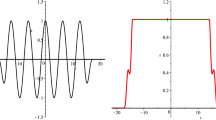Abstract
Segal proposed transquantum commutation relations with two transquantum constants ħ′, ħ″ besides Planck's quantum constant ħ and with a variable i. The Heisenberg quantum algebra is a contraction—in a more general sense than that of Inönü and Wigner—of the Segal transquantum algebra. The usual constant i arises as a vacuum order-parameter in the quantum limit ħ′,ħ″→0. One physical consequence is a discrete spectrum for canonical variables and space-time coordinates. Another is an interconversion of time and energy accompanying space-time meltdown (disorder), with a fundamental conversion factor of some kilograms of energy per second.
Similar content being viewed by others
REFERENCES
F. T. Arecchi, E. Courtens, R. Gilmore, and H. Thomas, Phys. Rev. A 6, 2211(1972).
N. M. Atakishiyev, G. S. Pogosyan, and K. B. Wolf, “Contraction of the finite one-dimensional oscillator, ” Internat. J. Mod. Phys. A 18, 317–327 (2003).
J. Baugh, D. Finkelstein, A. Galiautdinov, and H. Saller, J. Math. Phys. 42, 1489(2001).
D. Finkelstein, Quantum Relativity (Springer, New York, 1996).
D. Finkelstein and A. Galiautdinov, J. Math. Phys. 42, 3299(2001).
A. A. Galiautdinov, IJTP 41, 1423(2002).
A. A. Galiautdinov and D. R. Finkelstein, J. Math. Phys. 43, 4741(2002).
E. Inönü, “Contraction of Lie groups and their representations, ” in Group Theoretical Concepts and Methods in Elementary Particle Physics, F. Gürsey, ed. (Gordon & Breach, New York, 1964), pp. 391–402.
E. Inönü and E. P. Wigner, Proc. Nat. Acad. Sci. 39, 510(1952).
A. Kuzmich, N. P. Bigelow, and L. Mandel, Europhys. Lett. A 42, 481(1998). A. Kuzmich, L. Mandel, J. Janis, Y. E. Young, R. Ejnisman, and N. P. Bigelow, Phys. Rev. A 60, 2346 (1999). A. Kuzmich, L. Mandel, and N. P. Bigelow, Phys. Rev. Lett. 85, 1594 (2000).
C. Nayak and F. Wilczek, Nucl. Phys. B 479, 529(1996).
I. E. Segal, Duke Math. J. 18, 221(1951).
F. Wilczek, Nucl. Phys. Proc. Suppl. 68, 367(1998); also hep-th/9710135.
F. Wilczek, hep-th/9806228 [LANL].
Author information
Authors and Affiliations
Rights and permissions
About this article
Cite this article
Baugh, J., Finkelstein, D.R., Galiautdinov, A. et al. Transquantum Dynamics. Foundations of Physics 33, 1267–1275 (2003). https://doi.org/10.1023/A:1025661209919
Issue Date:
DOI: https://doi.org/10.1023/A:1025661209919



